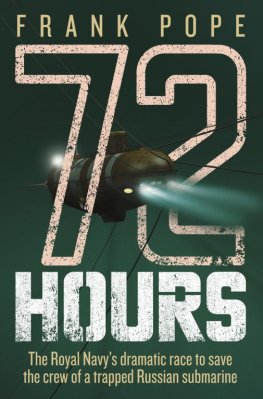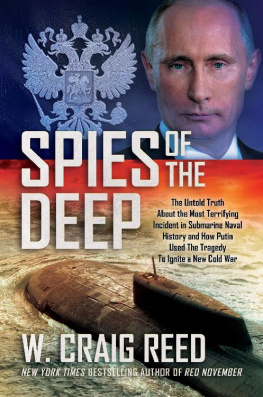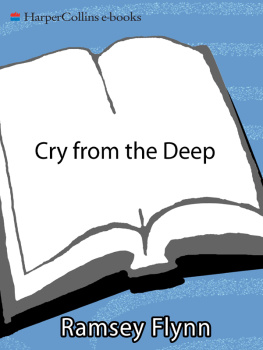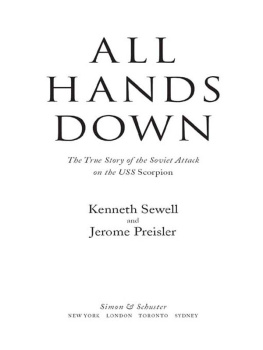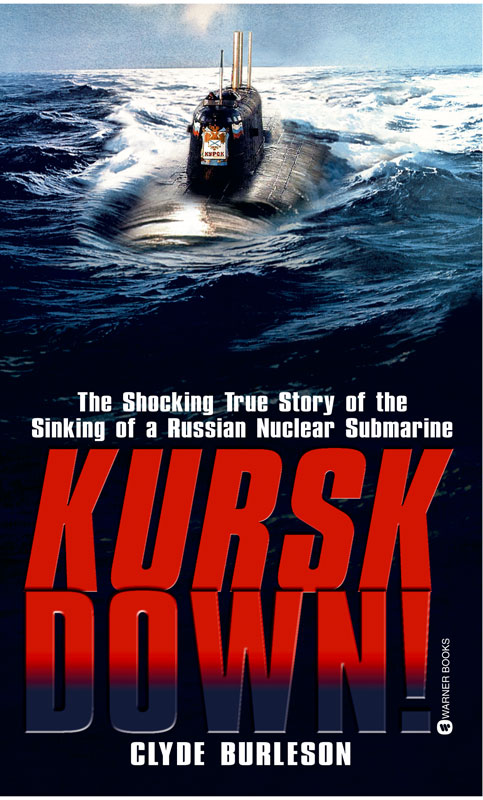Copyright 2002 by Clyde Burleson
All rights reserved. No part of this book may be reproduced in any form or by any electronic or mechanical means, including information storage and retrieval systems, without permission in writing from the publisher, except by a reviewer who may quote brief passages in a review.
Cover design by Diane Luger
Cover photography by Tony Greco
Warner Books, Inc.
237 Park Avenue
New York, NY 10017
Visit our Web site at www.HachetteBookGroup.com.
Warner Books is a division of Hachette Book Group, Inc.
The Warner Books name and logo are trademarks of Hachette Book Group, Inc.
First eBook Edition: March 2002
ISBN: 978-0-446-55456-5
KURSK DOWN! is the first complete story of the disaster and includes an inside-Russia look at the political calamity that ensued.
KURSK DOWN! provides information from translated official Russian Navy reports on the accident, then shows how details in this material have been altered to put the best face on actions taken by naval leaders.
KURSK DOWN! features exclusive interviews with rescuers.
KURSK DOWN! reveals the real reason behind the loss of this great vessel and her brave crew.
KURSK DOWN! conclusively proves what the Russian Navy was so loath to publicly admitthat an enormous explosion on board the Kursk sealed her fate.
THE FIRST BOOK
ON THE MARITIME DISASTER OF THE DECADE.
AND THE ONLY BOOK THAT GIVES YOU THE REAL STORY.
I am grateful to a very large number of people who assisted in developing the information contained in this book. Many of those who contributed do not wish to be named. In any case, it would require several pages to recognize all who assisted.
A few individuals, however, did much to help make this story possible. So a special thanks should go to Linda Stares for translations and explaining Russian customs, George Helland for his insights into Russia and information he provided, Karl Olivecrona for geographical assistance, Margaretha Olivecrona for help with language problems, John Brandon, Owen Osmotherly, and Nick Jones of Oil States MCS for technical information, and Peter Miller, who represented the book.
Several organizations also proved to be helpful. These include Bellona, a diligent and effective group, The Moscow Times, The St. Petersburg Times, the Russian Naval Museum, Itar-Tass, and www.kursk.strana.ru/www.kurskl4l.org, vital online news sources.
I also wish to single out Rob McMahon, the editor at Warner Books who had faith in this project and did such a valuable editing job. Thank you, Rob.
And thank you, too, Suzy, for everything.
Clyde Burleson
August 2001
We live in a communications and information age. Today, a newsworthy event that holds public attention is covered by the media with an unprecedented thoroughness, as well as a wide divergence of viewpoints.
All this makes it easier than ever before in history to amass a huge number of facts about any gripping incident. The sheer volume of available information, however, makes it difficult to organize it all into a manageable format. And often, that ordering process reveals conflicting reports, which produce more questions than answers.
That was the case in the development of KURSK DOWN!
The Internet provided access to daily news sources as well as trade publications in Russia, Europe, England, and the United States. These resources, when properly sorted, delivered an overall picture of the disaster. That same material also produced names and titles of people who were familiar with various aspects of the Kursk tragedy. Some of those individuals agreed to discuss the matter over the telephone. Many others did not. Language barriers provided additional stumbling blocks that had to be overcome.
Interviews produced new insights and provided a view beyond published reports. And as information was amassed, translations of official Russian Navy documents took on new meanings. From this vantage point, the structure, contents, and theme of the book became clear.
KURSK DOWN! is more than the recounting of a maritime disaster. It is an adventurous view of a great nation at a crossroadswhich makes the story all the more compelling.
THE BEAUTY
SHE WAS A BEAUTY. THERE WAS NO OTHER WORD. SHE SAT wide and low in the water, her curving hull a black that absorbed rather than reflected the soft Arctic summer sunlight. She was a leviathan of the deep, made by the hands of man to live under the sea. Here was a dark angel of death, a wreaker of havoc, bringer of war and destruction.
Those who served on her revered her. Some also feared her, because of her power and great size.
Although larger than most ships, submarines are traditionally called boats. This boat was named K-141 or the Kursknot a graceful title for a lady of her breeding. But the Russian Navy is more practical than poetic. And the city of Kursk, grateful for the honor, has a heroic past.
Shed first been christened Project 949A. Carefully conceived, she was a vastly improved enlargement of an earlier model. K-141 was one of the biggest nuclear attack submarines in the world.
Her design was radical. She had a double hull. The outer shell, called the superstructure, gave the boat its distinctive oval shape.
Covered with a rubberlike polymer that slicked the surface to add silence and more speed underwater, she had a dark, wet sheen as opposed to the dry look of paint on metal.
Between the superstructure and the inner hull was a space of some 7 to 12 feet. A thousand miles of wiring, hydraulic tubing, piping, and bracing, filled this cavity. Here, too, 24 cruise missiles were stored in their readyto-launch tubes. Submerged and hiding in the depths, K-141 could rip-fire a salvo of atomic warheads that doomed targets over 600 miles away.
The inner hull encapsulated the living part of the vessel with crew, controls, and nuclear reactors. Each compartment of the Kursk had three or four decks and housed a specific function. Watertight doors separated every section.
The design team planned the double hull to make her a hardier lady. They wanted her to be able to withstand a direct hit by a conventional enemy torpedo or depth charge. To reflect their intent, they dubbed her unsinkable!
K-141 was laid down in 1992 at the yards in Severodvinsk, a famed shipbuilding town on the Beloye More or White Sea. Skilled craftsmen cut and shaped each steel plate. Every centimeter of every weld was tested, every joint pressure-checked and x-rayed. Form followed function and beauty emerged. The boats function was devastation. Therefore, the beauty was tinged with subdued violence.
Launched in 1994, she was almost 500 feet long and nearly 60 feet wide. Lying still, her bottom reached some 30 feet beneath the cold water. The line of her vast curving deck was broken by a large sail or conning tower bearing the proud red and gold symbol of the Russian Navy. Jutting upward from the sail, like shining lances, were slender radio masts, periscopes, and air intakes.
At the rear, her huge rudder reached clear of the water, hinting at the boats enormous maneuverability.
Submerged, she was home. She could remain down for 120 days, traveling at a speed of 28 knots, and dive to depths approaching 3,000 feet. When running, she hummed and the twin propellers made a distinctive cavitation sound. When hiding, she could lie still and silent, defying detection.



